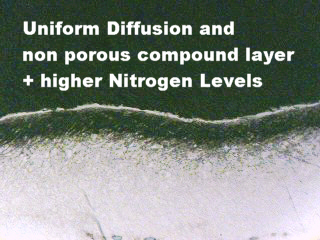|
Javascript DHTML Drop Down Menu Powered by dhtml-menu-builder.com

More Uniform Diffusion and Compound Layer
+
Higher Nitrogen Levels
The structure
of a diffusion zone is important. It must have uniformity with no cracks or
porosity in the compound layer. Cracking in this zone can cause
surface flaking to occur.
When
MetaLLife
is applied before
ThermaLLife,
any present porous structure is negated, plus a higher dislocation density is created
that allows more niitrogen to be diffused into the steel's surface.
The beneficial result of this is an increase in the fatigue strength of the
steel.

400x
In a recent Japanese study at Keio
University, testing was done to confirm this. The complete report is
available on our web site in the
Resource section.
Photos taken using a Scanning
Electron Microscope (SEM) show the difference between a standard nitrided and
TooLLife
like combination process surface. The photo at the right shows this comparison. The SEM
photos (a) shows cracks and pores at the surface in the niitrided compound
layer of the steel, while the
TooLLife
combination-like process (b) does not have these cracks or pores.
It was also observed in the report
that, if compressive stress (MetaLLife)
was applied before nitriding (ThermaLLife),
the amount of diffusion of Nitrogren was increased (b - below). This
concentration of diffusion zone increased the fatigue strength of the steel
over that of either process alone. This is exactly what
TooLLife
accomplishes.
Related Topics
> - Locks
compression |
